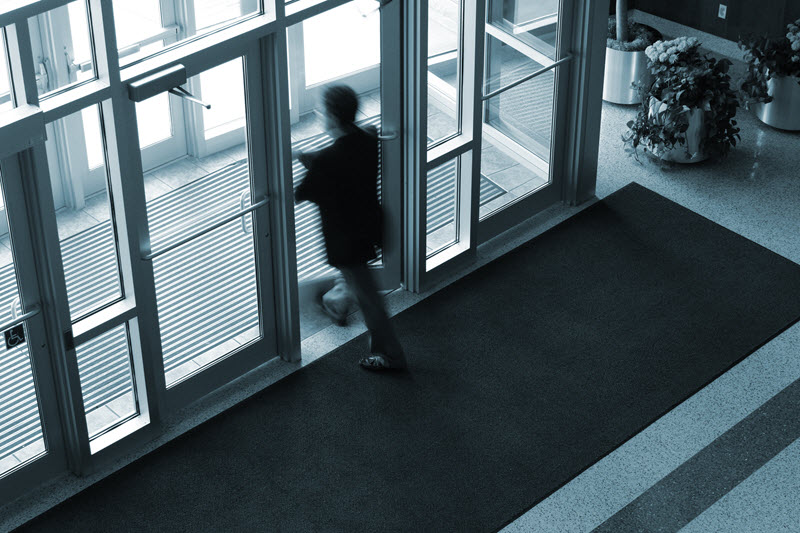
Does the sight of new-fallen snow leave you cold as you imagine the state of your office floors once people start to track it (and the ice melt on top of it) onto your flooring? Do you despise the mess that winter creates in the lobby of your business, as visitors bring snow, slush, and—worst of all—salt from the bottoms of their shoes?
Of course, everyone wants to make their sidewalks and parking lots as safe as possible for their employees and visitors. Ice melt products such as rock salt have been proven to be the most economical and most readily available substance to melt snow and ice even in frigid temperatures, so many custodial managers will make liberal use of it, applying it in large quantities all over the lots and walkways. As everyone treads through it before they walk into the office, they’re bound to bring it in on their shoes, but what, exactly, does it do to your hard flooring, in particular? And how do you sustain your concrete floor polishing efforts?
For starters, ice melt that’s been tracked into your building is simply unattractive. Nothing makes your lobby look sloppy faster than a dirty floor, and rock salt, in particular, is noted for leaving a white, powdery residue on your floors that will (if left unattended) dull or even damage the finish of your floor. Other forms of ice melt, such as calcium chloride or magnesium chloride, could leave a residue that’s oily in nature, and that will not only be slippery but could also damage to the floor’s finish.
So, how do you keep your floors looking their best without sacrificing the safety of your employees and guests? Ice melt is here to stay, but it’s wise to use it sparingly. Utilizing a fertilizer spreader to sprinkle it over your walkways and parking lots evenly is recommended rather than scooping or shoveling, which could result in using more than is strictly necessary to keep the surfaces free of ice. All of that extra ice melt will simply end up stuck on the bottom of everyone’s shoes, where they’ll track it into your building, and leave it on your floors. If you’re concerned that slipping could occur as snow continues to accumulate and cover over the ice melt you’ve already laid, plan to reapply regularly to ensure a fall-free snow storm.
Many building owners or managers dislike the look of the long, unattractive runners in their entryway. However, if you wish to preserve your floors, you’re going to have to learn to embrace the runner. In an ideal world, your visitors or employees wouldn’t bring in the ice melt and slush with them, but in reality, if you want to maintain your floors, you’re going to have to accept floor mats for the duration of the winter. There’s nothing better for trapping the ice melt and soil before it enters the building.
If you only have a 3- to 4-foot mat in your entry, shoes will only hit the mat about 2 times. That is not nearly long enough if you want the mat to capture the ice melt before it lands on your hard floor surfaces. It makes more sense to extend the mat to at least 12 feet and in some cases 15 feet during the snowy season. A quality commercial floor mat will absorb a significant amount of the detritus before it gets tracked onto your flooring, so it will save you time and effort in the long run. If you add a heavy duty scraping mat outside of the door, you will remove even more ice melt and snow before they even walk in the building, which will also help your floor mats stay a little cleaner.
Over the course of the winter, you should probably plan to clean your floors at least 2-3 times per day depending on foot traffic. In addition to this, it’s smart to add an extra protective coating in the form of a durable acrylic finish to your floor prior to the first snowfall, to further preserve your flooring when the salt inevitably starts to take its toll. This will simply help you keep the floor under the finish looking its best, but it will still require you to clean it frequently. If you note any sludge or puddles on the floor, clean it immediately, to prevent damage to your flooring. Otherwise, plan to mop during slow periods throughout the day, and dry the floors thoroughly to prevent slipping.
Winter is an unfortunate fact of life, but you can help preserve your floors and improve the appearance of your building by utilizing ice melt responsibly as well as implementing additional floor mats and extra cleanings throughout the day. If you subcontract your cleaning to a commercial cleaning company, discuss their floor maintenance plan to ensure they’re able to stay on top of the cleaning as scheduled. They may also provide day porter services, which would enable them to do the interim maintenance throughout the day.
If you’re in need of a commercial cleaning service with experience to handle all types of floor care, be sure to give us a call, we’re here to help keep your building in top shape!









